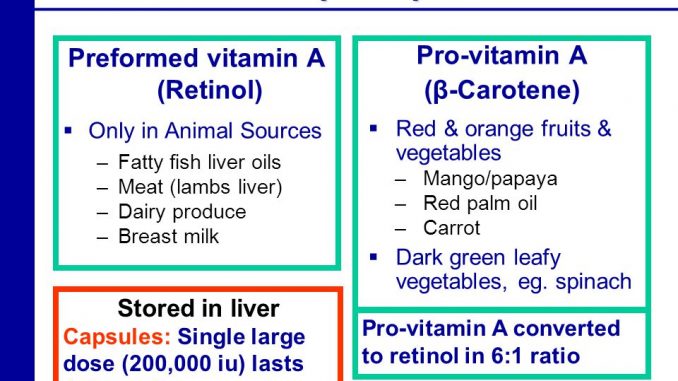
The two main forms of vitamin A in the human diet are preformed vitamin A (retinol, retinyl esters), and provitamin A carotenoids such as beta-carotene that are converted to retinol.
Table of Contents
What is Retinol?
- Retinol is a pure and active form of Vitamin A. Retinol fall in the family of retinoids.
- It is mainly found in animal sources that contains fat.
- The major sources of retinol are animal products like meat, liver, cod liver oil, kidneys, liver plate, butter, cheese, egg yolk and oily fish.
- Retinol is primarily stored in liver and fatty tissues.
- Retinol is mainly found in animal products, supplements and fortified foods.
- Retinol is considered as the most potent and strong type of Vitamin A.
- Studies have shown that retinols have 12 times stronger effect than B-carotene. It is a type of preformed Vitamin A.
- Retinol is mainly required in the body for the production of rhodopsin.
- The metabolism of retinol depends on the zinc. It requires zinc to be released from the liver.
- Since, retinol is in a pure and active form, higher consumption of retinol might hazardous due to its overdose. Thus, it should be consumed in a limited amount
What is β -carotene?
- β -carotene is a precursor of Vitamin A.
- β -carotene lies in family of carotenoids. It is a type of provitamin A carotenoids.
- It is primarily found in plant foods.
- β -carotene is a red-orange pigment found in fruits and vegetables. E.g. carrots and colorful vegetables.
- Major sources of β-carotene are green leafy vegetables and fruits like carrots, spinach, tomatoes, parsley, rosehips, kale, peas, mango etc.
- Unlike retinol, β-carotene does not get stored in the liver. It gets converted to retinol in the intestinal mucous membrane.
- Bio-efficacy of β -carotene conversion to retinol is generally poor even for pure β-carotene unless the dose is small and fed regularly until equilibration is reached.
- β -carotene is very important for our health because of its antioxidant properties. It has high antioxidant property which neutralizes free radicals that damage the tissues.
- Although, it has antioxidant properties, β-carotene is considered as the weakest form of Vitamin A as compared to the retinol.
- However, it is considered safer for supplementation as it is impossible to be overdosed.
Similarities between Retinol and β-carotene:
- Retinol and β-carotene both are lipid soluble.
- Both these forms of Vitamin A must be metabolized intracellularly to retinal and retinoic acid, the active forms of vitamin A, to support the vitamin’s important biological functions.
Now let us look at the differences between them.
The differences between retinol and β -carotene are:
Basis of difference |
Retinol |
β -carotene |
| Form | Retinol is a pure and active form of Vitamin A. | β -carotene is a precursor of Vitamin A. |
| Type | Retinol is a type of preformed Vitamin A. | β -carotene is a type of provitamin A carotenoids. |
| Family | Retinol falls in the family of retinoids. | β -carotene lies in family of carotenoids. |
| Animal/plant source | Primarily found in animal sources that contains fat. | Primarily found in plant sources. It is a red-orange pigment found in fruits and vegetables. E.g. carrots and colorful vegetables. |
| Example of sources | Sources of retinol are meat, liver, cod liver oil, kidneys, liver plate, butter, cheese, egg yolk and oily fish. | Source of B-carotene are green leafy vegetables and fruits like carrots, spinach, tomatoes, parsley, rosehips, kale, peas, mango etc. |
| Storage | Retinol is primarily stored in liver and fatty tissues. | β-carotene does not get stored. It gets converted to retinol in the intestinal mucous membrane. |
| Bio-efficacy | Recent studies have shown that retinols have 12 times stronger effect than B-carotene. | Bio-efficacy of β -carotene conversion to retinol is generally poor even for pure β-carotene unless the dose is small and fed regularly until equilibration is reached |
| Antioxidant property | Retinol does not have enough antioxidant property. It is rather required for production of rhodopsin. | β-carotene is a powerful antioxidant. It has high antioxidant property which neutralizes free radicals that damage the tissues. |
| Metabolism | Retinol requires zinc to be released from the liver. | β-carotene gets converted to retinol and thus does not require zinc for its release. |
| Strength/potent | Retinol is considered as the most potent and strong type of Vitamin A. | β-carotene is considered as the weakest form of Vitamin A. |
| Nutrient property | Retinol is itself an essential nutrient. | β-carotene is itself not an essential nutrient. |
| Chances of overdose | Higher consumption of retinol might cause overdose. | β-carotene is impossible to overdose. Therefore, there is no need to monitor the intake level of β-carotene. |
| Safety | Need to be cautious of overdose during supplementation. | It is safer for supplementation. |
| Amount needed | Less is more: limited amount of retinol is also enough for body. | More is less: The need for β-carotene is much greater compared to retinol form of Vitamin A. |
References and For More Information:
https://www.healthandscience.eu/index.php?option=com_content&view=article&id=466:vitamin-a-retinol-and-beta-carotene&catid=54&lang=en&Itemid=327
https://www.sharecare.com/health/vitamin-a/vitamin_a_beta_carotene
https://ods.od.nih.gov/factsheets/VitaminA-HealthProfessional/
Vitamin A and the Beta-Carotene Myth: “A” is for Athletics, Aging and Advanced Health
https://www.ncbi.nlm.nih.gov/pmc/articles/PMC5090096/
https://www.medicalnewstoday.com/articles/252758
https://academic.oup.com/jn/article/133/9/2915/4688113
https://www.sciencedirect.com/topics/biochemistry-genetics-and-molecular-biology/beta-carotene
https://onlinelibrary.wiley.com/doi/pdf/10.1002/jsfa.2647
https://link.springer.com/chapter/10.1007/978-1-4899-1789-8_7